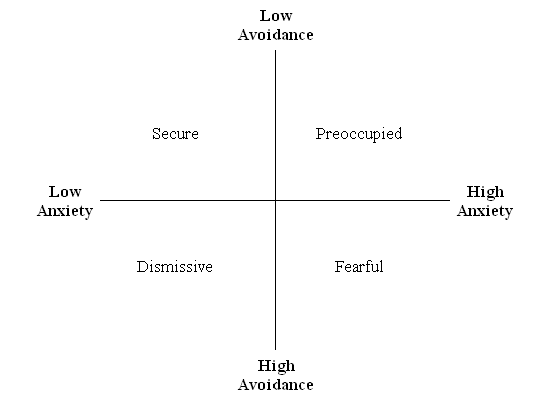View this post on Instagram
I first learned about adult attachment theory when I was recovering from a toxic relationship with someone who was troubled, erratic, and intimidating.
While reading Attached, by Amir Levine and Rachel Heller, I immediately identified with having an anxious or preoccupied attachment style.
The book clearly illustrated the anxious-avoidant trap I had experienced in my intimate relationships. I saw myself in the descriptions of anxious/preoccupied individuals—people who move toward intimacy but experience high anxiety in relationships.
Besides relating to the description, every online assessment I took said I had an anxious or preoccupied attachment style. Learning about anxious attachment provided me with an opportunity to understand myself better. It also made my desire for intimacy not seem like a codependent personality defect, but an instinct I shouldn’t be ashamed of. I could view my relationship patterns from a fresh perspective. A perspective free from the anxiety and shame I typically experienced in relationships.
With this insight and new confidence bolstered by a brief stint in therapy, I began dating again. I felt like I’d wasted enough time on my last relationship and I wanted to get on with my life. I met a guy, quickly fell for him, and just as quickly learned he was, there is no pleasant way to say this, a pathological liar.
Shattered by this brief but devastating experience, I dedicated myself to a longer stint in therapy and a deeper exploration of adult attachment theory. During this time, I was still trying to date, but finding my attempts frustrating and confusing. I still wanted a relationship and moved toward intimacy, but I approached dating with more trepidation and less trust. I was fearful and felt like anyone I was interested in would ultimately hurt and disappoint me. This negative outlook left me feeling pessimistic about my ability to find and maintain a happy relationship.
I gained more clarity on my recent toxic and traumatic relationships while going to therapy. I came to realize I wasn’t just exhibiting anxious attachment behaviors; I was also exhibiting dismissive or avoidant behaviors. People who exhibit both anxious behaviors and avoidant behaviors have the fourth and rarest attachment style—disorganized, or fearful-avoidant attachment.
Individuals with a disorganized attachment style have inconsistent behavior in relationships—sometimes moving toward intimacy and alternately pulling away. People with a disorganized or fearful-avoidant attachment style want intimacy and a relationship, but they often struggle to trust people. This is how I feel about and approach relationships now—but looking at my childhood left me scratching my head, wondering how I could have developed a disorganized attachment style.
It is universally accepted that our early life experiences with our primary caregivers determine our attachment style as adults. Most people with disorganized attachment come from homes where neglect and abuse were common. This is not the case with me. My parents are loving and supportive. Of course, I didn’t make it to adulthood without some traumatic experiences. We all have trauma, but my childhood is not what is described as typical for people with disorganized attachment. I could understand how the challenges of my childhood had made me anxious or preoccupied with my relationships, but I didn’t understand how my childhood could have led to the development of a disorganized attachment style.
All my intimate relationships from my teens, through my 20s, and into my 30s were a classic anxious-avoidant push and pull dynamic.
Until my 30s, all I knew of love was the anxious-avoidant trap. Having typically dated dismissive or avoidant partners, I slipped effortlessly into my role as an anxiously attached individual. Was I only finding out now that I actually have a disorganized or fearful-avoidant attachment style because I was finally dating people who were not obviously dismissive or avoidant? Possibly; I suspect I dated three men in succession who might have a disorganized attachment style.
I believe my previous long-term toxic and abusive relationship actually shifted my attachment style. I never experienced abuse or neglect as a child, but I experienced abuse and neglect in that relationship. This realization has led me to believe we might put too much emphasis on our childhood wounds and not give enough credit to the effect our traumatic adolescent and adult relationships might have on our attachment style.
This realization has me thinking everyone should be more careful about who they date, considering the enormous impact a relationship can have not only on your attachment style but on your mental health and general happiness in life.
When I take attachment style quizzes now, I almost always test as disorganized/fearful-avoidant, or near the line where fearful-avoidant and anxious/preoccupied meet. I think looking at the graphic of the four attachment styles is helpful in understanding that attachment styles are a spectrum, and they can shift based upon your life experiences. Even the experts agree on that.

While I used to be solidly in the preoccupied quadrant, I now hover somewhere on the borderline between preoccupied and fearful. In some ways, I feel like I have moved toward secure attachment, but it seems like I’m just moving toward the axis of this graph.
I think a lot of us have experienced a shift in our attitude about relationships and our approach to dating after a particularly nasty breakup, or after finding a stable and happy relationship. I remember, after my first love and I broke up, I was solidly dismissive for a while. I went from hyper preoccupied to completely not interested. But after healing, when I finally trusted someone with my heart again, I went right back to being preoccupied or anxious in my attachment style. I think it is understandable when a person feels like they have made a huge mistake, they might overcorrect.
A while back, a friend of mine was talking to me about this exact thing. She was sharing a story about watching the massive pendulum at the Academy of Sciences in San Francisco as a child. She stood there watching the pendulum for hours, seeing how it wildly swung back and forth, oscillating from one extreme to another. But she noticed, over time, the movements became smaller until the pendulum finally lost momentum and found its center. Maybe that’s what I’m doing? Maybe I’m slowly creeping toward the center of the graph.
Maybe all we can hope for while healing from trauma is to find our center and to find balance again.
Hopefully from our center, we can rebuild into someone secure. Someone comfortable with intimacy, confident in their ability to respond to the needs of the ones they love. Someone who can show up fully for themselves and others. Someone with healthy boundaries and self-confidence.
Hopefully, we can become a reflection of the type of partner we want and deserve—and maybe, by becoming this person, we will realize the love, support, and acceptance we were looking for in others was always inside of us.
~







Read 18 comments and reply